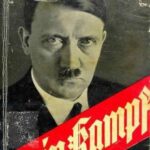The uprising of the Jews in the Warsaw Ghetto is an event that stands out in history as a great achievement of humankind. Despite the conditions faced, and absolute authority of the German powers, the Jews still managed to operate and execute a legitimate resistance force that, if not a grand success in regards to aiding the destruction of the Nazi machine, was successful insofar as it dealt a massive blow to the pride and prestige of the German political regime.
The tenacity and resilience with which the Jewish resistors fought with, in the midst of starvation and utter privation, is both heroic and seemingly impossible. Yet, the struggles with which they battled (aside from the German forces) were overcome so that a formidable, if not large, force was created. For over sixty days the Jewish resistance forces battled with German, Latvian, and Ukrainian forces in an effort to revenge some of the horror, sorrow, and humiliation that had been dealt upon them for years.
A study of the Warsaw Rebellion is both a study of a historical event and a study of human will. It is a study of sorrow and a study of heroism; of defeat and the strength of the human spirit.
Leading Up to the Rebellion
There were many forces competing within the walls of the ghetto. On one side there was the Judenrat, which advocated compliance and cooperation with the German forces. It was not believed that the Nazi’s final aim was the complete annihilation of the Jewish population, and that cooperation would earn favor, thus lives would be spared. On the other hand there were the underground factions, those groups that did not advocate capitulation with German orders. As expected, it was not from the Judenrat that the opposition resistance forces emerged (Hilberg 200).
Long before launching the armed resistance in the spring of 1943, the resistance forces were operating subversively. However, this operation consisted of clandestine acts of literature distribution – “verbal action” according to Hilberg (200). These actions were taken up by almost all of the various parties within the Ghetto underground, and the “publication of newspapers assumed a place of primary importance among the party activities” (Gutman 125).
Indeed, in these early years the groundwork was being laid for the rise of the more militant Jewish resistance that would be seen later. Through these covert political activities Jewish groups were creating allies, building stronger, broader-based coalitions. However, in these early years many groups still did not believe that the Nazi’s would set out to wholly eliminate the Jewish population. This belief would cause the deportation of hundreds of thousands of Jews out of the Ghetto.
As word grew of the developing underground in the Ghetto, Nazi officials began to look for ways in which to quell the growing opposition and rising spirit among the populations. After visiting the Ghetto in the winter of 1942, Himmler ordered the immediate deportation of 8,000 Jews (Hilberg 207). During the attempted deportation one German officer was wounded by a gunshot. It was after this encounter that Himmler ordered the complete dissolution of the Ghetto (Hilberg 207).
It was not until the major Aktionen during the fall of 1942 that Jews began to believe that their fate in the hands of the Nazis was not a safe one. While there had been some previous rumors of ill intent in the minds of the Nazi regime, this Aktionen solidified the murmurs circulation throughout the ghetto population. It was in the midst of the deportations that the first action was taken on behalf of armed Jewish resistors. The first action was an assault on Jews collaborating with German orders via the Judenrat. In August 1942, an assassination attempt was made on Jewish police chief Szerynski. From that moment on the Judenrat gradually began to lose all power and authority within the Warsaw Ghetto.
However, despite marginal efforts as armed resistance, the question after the major Aktionen, which resulted in over 300,000 Jews to be deported, leaving approximately 70,000 remaining in the ghetto (Hilberg 204), was why the resistance movement did not act prior to the German mobilization. As Ringelblum asks: “Why didn’t we resist when they began to resettle 300,000 Jews from Warsaw? Why did we allow ourselves to be led like sheep to the slaughter? Why did everything come so easily to the enemy?” (310). It was a question that would remain unanswered. But, it was a question that would be addressed, indirectly, in the actions and efforts after the major Aktionen of the fall of 1942.
After the Aktionen, Jews began to realize their fate and began to arm themselves in an effort to mount a resistance. “Those who remained in the ghetto were, for the most part, able-bodied, bereft, and desperate” (Dwork and Van Pelt 255). Thus, with nothing left, except to follow the footsteps of their murdered family members, friends, and loved ones, “armed resistance at least offered revenge, even if it did not promise survival” (Dwork and Van Pelt 256). This sentiment- one that the Jews remaining in the Ghetto were driven by desperation- is countered by Mark’s thoughts on the rise of the Ghetto resistance. He says, “No matter how tragic the circumstances of the Warsaw Ghetto Uprising, the act of uprising was not one of despair” (5). He goes on to say that the uprising was “the direct result of a long process, realization of a dream not only of self-defense but also of enlisting in the fighting ranks of local and international revolutionary movement” (Mark 5). It’s hard to argue against the assertion that the resistance leaders were motivated out of desperation when armed resistance was delayed until it was clear that the fate of the Jews was that of liquidation.
When the resistance forces collaborated the first organizational name was the Anti-Fascist Bloc. The name lends credence to another of Mark’s assertions, “The very name of this first communal organization- Anti-Fascist Bloc- indicates that the pioneers of active resistance…had greater ideas behind their opposition than mere self-defense” (Mark 5). While this may indeed be correct, it in no way clarifies or supports his claim that the resistance forces were not acting out of desperation. Regardless of motivations, however, from the AFB emerged separate forces bent on armed resistance.
There were two major fighting forces that emerged. The first was the Jewish Fighting Organization (ZOB). The second major group was the Jewish Military Union (ZZW). In the last three months of 1942 the ZOB and ZZW began to organize militarily in an effort to create an armed Jewish resistance. During this time they set for themselves two main tasks: the “organization, training, and acquisition of arms”; “elimination of traitors and collaborators” (Ainsztein 64). The charge to acquire arms, however, proved to be difficult. The groups were only mildly successful in obtaining arms for the fighting units. Most of the weapons they procured were bought at outrageous prices from private dealers looking to profit from the desperation of the forces; and many of the arms given were unserviceable. Compounding the problem was the obtainment of ammunition. This was a task that was found to be as difficult, if not more so, as procuring weaponry. In the end, Jews ended up producing on their own many of the grenades and Molotov Cocktails that were used during the resistance.
Despite the hardships of organizing and arming such a resistance, the organization and fighting of the Jews would cause Brigadefûhrer Juergen Stroop to say six years after the events: “The fighting in the ghetto was really tough. Whatever others may say, I shall always hold that the Jews had prepared themselves well for the battle and that they had demonstrated great fighting qualities…This was a truly impressive achievement!” (Ainsztein 99-100). An order from Himmler to liquidate the Jews from the Ghetto- making it Judenrein for Hitler’s birthday (Mark 12)- was to be completed by April 19. It was then that the Jews would be forced to take up arms and make a final resistance against the Nazi war machine.
The Uprising of 1943
In the early hours of the morning on April 19, as German and allied forces prepared for the final liquidation of the Ghetto, the rebels were making their own final preparations. As German and allied troops were led into the ghetto they were greeted with a hail of fire from Jewish resistors. Quoting from Ainsztein, a prominent Nazi official would later say of the resisting forces, “the Jewish rebellion was unanticipated, amazingly forceful, and a great surprise” (20). This was the beginning of the major stand taken by the Jewish resistance forces that would last into the first part of July.
The campaign of Jewish resistance can be separated into three distinct phases. Phase one was from the opening of the campaign until April 23; phase two went from April 23 until May 10; and the final phase of the campaign lasted from the end of the second until the final vestiges of the main resistance were eliminated toward the end of July.
Phase One: April 19-23
The opening phase of the campaign was aimed at driving back Nazi and allied forces as they tried to enter the ghetto to force the final liquidation. The success with which the resistors carried out their plans in these early days of fighting can be illuminated by a prominent Nazi official being quoted as saying, “All is lost in the Ghetto! We’re no longer in the Ghetto! There’s no way to get in there! We’ve got wounded and dead!” (Mark 24).
The early part of the armed struggles were marked by success of Jews in defending themselves by use of grenades and Molotov cocktails, as well as the scarce arms they were able to procure leading up to the confrontation. However, these limited supplies would only hold up for a very short time against the heavily-armed, superior German forces.
Hoping to exploit this fact, the Germans offered the Jewish resistors an ultimatum on the second day of fighting (April 20). Mercy was offered in exchange for surrender from the resistance forces; or the Jews would face a razing of the Ghetto (Mark 30).
Phase Two: April 23-May 10
Realizing that their scarce supply of arms could not hold up long against the German and allied forces, a second phase was initiated in the plan of resistance. April 23 marked “the strongest resistance [that] was put up by the combat groups…” (Ainsztein 121). Also going on was the burning of German factories and warehouses so as to prevent the German forces to remove any machinery or raw materials that had been produced by the Jewish labor forces.
The second phase of the resistance marked a turn in tactics for the Jewish resistance. Now taking precedence was the obtainment and procurement of additional arms and ammunitions supplies. This was to be done by pilfering weapons and supplies from enemy fighters or succeeding in securing aid from outside the ghetto walls. The fighters within the walls were successful in securing a supply of arms from a faction of the Home Army, and also by taking the supplies from injured or dead German forces.
This period in the struggles also marked a devastating blow to the Jewish resistors. On April 26 a house in which a large cache of arms was stored caught fire. In the ensuing flames the arms cache exploded. This was a detrimental event to an already under-armed guerilla force. Stroop hoped that this event would lower the morale of the resistors and offered yet another ultimatum. The German ultimatum was again rejected, and Anielewicz wrote in a letter: “Our last days our approaching. But so long as we have arms in our hands we will continue to fight and resist” (Ainsztein 127).
In an effort to ferret out and defeat the resisting factions, and in an effort to spare the lives of the “superior” Germans, German commander Stroop ordered new tactics to be used against the Ghetto fighters. The ghetto was to be set aflame. Stroop was hoping that this would root out the bunkered resistors and make for an easy round-up of Jews in the ghetto. Stroop also ordered an intensified attack against the fighters in hopes that the pounding assault would unnerve the resistors and lead to their surrender.
In the early days of May, the German forces relentlessly assaulted the Jewish fighters. But the resistors refused to be taken alive. Their refusal to surrender was noted by Stroop when he wrote of observing “insurgents shooting with pistols in both pistols in each hand (their own and their dead comrades’), and the special gameness of the women fighters” (Mark 68).
Phase Three: May 10- Mid-July
Despite the tenacious resistance with which the Jewish resistors fought, the reality of their inferior weaponry (both in power and supply) and their inferior training militarily was soon to catch up. As the German forces continued to strafe the Jewish quarters with heavy artillery, the Jews were soon running out of ammunition and weapons with which to strike back with, as well succumbing to fatigue and hunger. Mark describes this phase of fighting as consisting of “sporadic skirmishes among ruins of a gutted Ghetto” (77).
Having lost much of their forces and leadership, new groups of fighters arose spontaneously and tried to mount a resistance against the German forces. The Jewish fighters fought “until their last round of ammunition and their last Molotov cocktail” (Ainsztein 158). Despite the desperate situation, however, Jews remained resistant into July, with roving bands of fighters- “wild groups”- combing the destroyed ghetto for food, water, or arms.
In the second half of July, however, Stroop devised a plan to put an end to the roving bands of Jewish resistance left in the ghetto. “The Germans proceeded…to blow up the mountains of rubble and ruins,” where “bunkers, cellars, underground passages and accesses to the sewers, which were the last source of water, were systematically destroyed” (Ainsztein 158-159). Ainsztein goes on to say how these actions “thus [reduced] even further the terrain where the Jews could still operate” (159).
The Uprising of 1944
During the uprising of 1943 many Jews were evacuated to the forests surrounding the Ghetto. Many Jews remained in the forests surrounding the ghetto until struggles resumed again in the fall of 1944. During the period where fighting was thought to be over, there were some Jews still hiding out within the Ghetto walls. They were aided with food rations and other supplies by runners from the forest.
In the fall of 1944, these fighters, aligned with Home Army units, began more armed battles against German forces. However, this alliance lasted only until the Home Army leader, the Anti-Semitic Bor- Komorowski capitulated to German demands. The Jews were able to build an underground bunker before this event, however, and load it with arms and other supplies (Ainsztein 167). The group holed-up in the bunker was able to remain secure until 1945 when the German forces were forced out by the advancing Russian army.
Conclusion
The accomplishments of the Jewish fighting forces during the Warsaw Ghetto rebellion are feats that are commendable on several levels. On one is the adversity that the inhabitants of the Ghetto had to overcome. Through hunger, death, grief, loss, constant physical and verbal abuse- a regiment based on and operated for the purpose of terrorization- a successful campaign of resistance was launched against a much more powerful, more trained, and more heavily armed opponent.
While the resistance of the Warsaw fighters may not have achieved a victory based on body count, lives saved, or other material counts, the effort they mounted was a victory for the spirit of humankind. It was a victory over adversity, and it attacked the very persona that the German believed she or he was an in some way an inherently superior race.
Bibliography
Ainsztein, Reuben. 1979. The Warsaw Ghetto Revolt. Waldon Press: New York.
Dwork, Deborah and Robert Jan van Pelt. 2002. Holocaust: A History. W.W. Norton
And Company: New York.
Einwohner, Rachel L. 2003. “Opportunity, Honor, and Action in the Warsaw Ghetto
Uprising of 1943.” American Journal of Sociology 109,3: Pp. 650-675.
Gutman, Yisrael. 1982. The Jews of Warsaw, 1939-1943: Ghetto, Underground, Revolt.
Indiana University Press: Bloomington.
Hilberg, Raul. 1985. The Destruction of the European Jews. Holmes and Meier:
New York.
Mark, Ber. 1975. Uprising in the Warsaw Ghetto. Schocken Books: New York.
Sloan, Jacob, ed. 1975. Notes from the Warsaw Ghetto: The Journal of Emmanuel
Ringelblum. Schocken Books: New York.
Werner, Harold. 1992. Fighting Back: A Memoir of Jewish Resistance in World War II.
Columbia University Press: New York.
Yad Vashem: The Holocaust Martyrs’ and Heroes’ Remembrance Authority. 2004.
“No Child’s Play.” Retrieved March 31, 2004.
http://www.yadvashem.org.il/exhibitions/temporary_exhibitions/childsplay/lexicon/warsaw_ghetto_uprising.
html.




